In what has been billed as the last electoral test before India goes to the polls for national elections later in spring 2014, a series of five regional contests in northern India are being cast as a sign of strong momentum for India’s conservative Hindu nationalist Bharatiya Janata Party (the BJP, भारतीय जनता पार्टी) and for its charismatic leader Narendra Modi.![]()
Results were released yesterday and today in the five state assembly elections, though regional voting started nearly a month ago on November 11 in Chhattisgarh.
Though commentators are quick to argue that the results are a good sign for the BJP, with the Indian stock market and the Indian rupee surging on news of the BJP victories, it’s important not to confuse an anti-incumbent electorate with an electorate that’s suddenly enthusiastic about a new era of BJP dominance.
Still, the momentum in favor of Modi and the BJP — and against India’s current governing party, the center-left Indian National Congress (Congress, or भारतीय राष्ट्रीय कांग्रेस) — has been growing for quite some time. Many Indian voters are growing weary of a decade of Congress-led rule under prime minister Manmohan Singh, who has been unable to repeat his success as finance minister in the 1990s, when he enacted a series of liberal economic reforms. Neither does the Indian electorate seem excited about Rahul Gandhi, who would succeed Singh as prime minister if the Congress-led United Progressive Alliance (UPA) wins a majority in next spring’s elections. The Indian economy has slowed significantly over the past three years — GDP growth dived from over 10% in 2010 to under 3% last year (and it’s set to grow just 5% this year).
In that regard, Modi’s massive reelection victory to a third term in December 2012 as Gujarat’s chief minister and Congress’s failure to make a breakthrough in the February 2012 Uttar Pradesh state elections are important goalposts as well.
So what actually happened in the latest round of state assembly elections?
Here’s a map of the five states/territories in play, the three largest of which (Madhya Pradesh, Rajasthan and Chhattisgarh) form a wide swath of India’s north-central Hindu heartland. Unlike in many other Indian states, including Uttar Pradesh, Bihar, West Bengal and Kerala, politics in the three north-central states are about as vanilla as Indian politics gets — the state elections were essentially two-party contests between the BJP and Congress. That made the contests important bellwethers as national elections approach.
So how did the parties do?
The BJP will retain its hold on the state of Madhya Pradesh with a moderately larger majority, giving chief minister Shivraj Singh Chouhan (pictured above) a third consecutive term leading India’s sixth-most populous state. The BJP will also retain control of Chhattisgarh’s state assembly. The BJP’s most impressive victory, however, came in Rajasthan, India’s eight-most populous state, where Congress lost 75 seats and the BJP gained 84.
In Delhi, voters also rejected Congress, but not in favor of a majority BJP government. Instead, voters turned to the newly formed Aam Aadmi Party (AAP), an anti-corruption party, which fell three seats short of becoming the largest party in Delhi’s assembly, and which now holds the key to Delhi’s new government.
Congress remained in government only in the small far-eastern state of Mizoram.
While the result, on average, is better news for Modi and the BJP than for Congress, the results (with the exception of Rajasthan) don’t necessarily mean a huge BJP wave is coming. Modi still has two major problems — the first is the hubris of mistaking an anti-incumbent mood for BJP support, and the second is geography.
Nothing demonstrates both problems more than the May 2013 elections in Karnataka state in south-central India. Going into those elections, the BJP had presided over one of India’s most powerful regional economies — Karnataka is home to Bangalore and a booming high-tech economy that has drawn massive amounts of global investment. While Modi campaigned in Karnataka just as vigorously as he did in the most recent elections, it wasn’t enough to save the incumbent BJP government from a spectacular defeat — the BJP lost 70 of its 110 seats in the Karnataka state assembly. Though the Karnataka election also featured unique internal BJP fractures, it’s a potent example that voters have been equally brutal against the BJP this year, too.
But Karnataka, as the first major southern state to elect a BJP government, was supposed to be a model for the BJP’s growth outside of its traditional northern heartland. After this weekend’s election results, the four largest states under BJP control will be Madhya Pradesh, Rajasthan, Chhattisgarh and Modi’s Gujarat, which lies on the coast south of Rajasthan and west of Madhya Pradesh. In southern and eastern India, the BJP remains a relatively minor political force and, until that changes, Modi will never be able to win an outright BJP majority. Instead, the best-case scenario for Modi is to build a coalition with regional and other parties through the National Democratic Alliance (NDA), the BJP-led coalition alternative to the UPA.
Pushing aside national political considerations, here’s a look at the results on a state-by-state basis.
- Election Date: November 25
- Population: 72.6 million
- Current Chief Minister: Shivraj Singh Chouhan (BJP)
- Largest Cities: Bhopal (capital), Indore, Jabalpur, Gwalior
- Official Languages: Hindi
- Religion: Hindu 87%, Muslim 11%, Jain 0.9%
- Legislative Assembly: Unicameral, 230 seats
- GSP per capita (2009-10): ₹27,250 (Indian average ₹46,492)
Madhya Pradesh was the largest prize among the five regional elections, though it remains one of India’s poorest economies.
That didn’t stop Chouhan from adding to his majority in the state’s legislative assembly i his third consecutive term — the BJP picked up 22 seats, while Congress lost 13 seats and the minor, center-left Bahujan Samaj Party (BSP, बहुजन समाज पार्टी) lost three seats. The victory establishes the mild-mannered Chouhan as the BJP’s chief counterweight to the brasher Modi. As chief minister of Madhya Pradesh since 2005, Chouhan could also be considered a prime ministerial candidate in the future — many Indians, including some within the BJP, believe Chouhan would be a better prime minister than Modi:
However, it’s not the Sadhvi alone who is singing paeans for Chouhan. Even [senior BJP leader] LK Advani saw a prime ministerial prospect in him a few years back. About six months ago, Advani compared Chouhan with his supposed beta noire in the party, Narendra Bhai Modi, and dubbed Chouhan as a better chief minister. “Though Modi’s development of Gujarat is impressive, Chouhan managed to turn around a poorer state. Chouhan’s lack of arrogance has shades of iconic leader Atal Behari Vajpayee”, said Advani addressing BJP workers at Gwalior on June 1.
In light of corruption issues surrounding his government and the anti-incumbent mood, Chouhan’s win is more impressive than it seems. If Modi rose to national prominence on the basis of Gujarat’s economic strength and his government’s role in promoting investment and development, Chouhan’s signature policy is a mix of welfare schemes. In 2007, Chouhan introduced the ‘Ladli Laxmi Yojana’ program, which awards each girl born in the state a small stipend upon birth, with additional awards upon the successful completion of additional educational levels. As the BJP’s prime ministerial candidate, Modi would be wise to deploy Chouhan as an example of the BJP’s ability to implement successful programs to ameliorate poverty and promote social and economic equality.
- Election Date: December 1
- Population: 68.6 million
- Current Chief Minister: Ashok Gehlot (Congress)
- Largest Cities: Jaipur (capital), Jodhpur, Kota
- Official Languages: Hindi
- Religion: Hindu 88%, Muslim 8%, Sikh 1.5%, Jain 1.2%
- Legislative Assembly: Unicameral, 200 seats
- GSP per capita (2010-11): ₹39,967 (Indian average ₹54,835)
Rajasthan represents, by far, the most impressive BJP win of the cycle — a victory of landslide proportions that will return former chief minister Vasundhara Raje, who previously served between 2003 and 2008, to power. It was the BJP’s best-ever performance in Rajasthan and, conversely, the Congress’s worst-ever performance. Raje’s challenge will be to keep the BJP unified, a task that proved challenging during both her first stint as chief minister and later as leader of the opposition.
- Election Date: November 11, November 19
- Population: 25.5 million
- Current Chief Minister: Raman Singh (BJP)
- Largest Cities: Raipur (capital), Bhilai
- Official Languages: Hindi, Chhattisgarhi (Hindi dialect)
- Religion: Hindu 98%
- Legislative Assembly: Unicameral, 91 seats (90 elected, plus one unelected member of the Anglo-Indian community)
- GSP per capita (2010-11): ₹44,097 (Indian average ₹54,835)
While Chhattisgarh is less populous than either Rajasthan or Madhya Pradesh, its economy is marginally stronger, with an industrial core that produces much of central India’s steel and electricity, though the state has one of India’s lowest standards of living. Raman Singh, the state’s chief minister since 2003, will join Modi and Chouhan in leading government through a third consecutive term, though the BJP actually lost one seat in the elections (while Congress gained one seat). The vote followed an attack in May by Naxalite (Indian communist) insurgents in Darbha that resulted in the deaths of several top Congress leaders. While that attack generated sympathy for Congress and called into question Singh’s ability to combat Maoist terrorism effectively, Singh has generated a reserve of goodwill for massive social welfare programs to subsidize health care and food to the state’s mostly rural population.
- Election Date: December 4
- Population: 16.8 million
- Current Chief Minister: Sheila Dikshit (Congress)
- Largest Cities: Delhi
- Official Languages: Hindi, Punjab, Urdu
- Religion: Hindu 81%, Muslim 11.7%, Sikh 5.0%, Jain 1.1%
- Legislative Assembly: Unicameral, 70 seats
- GSP per capita (2010-11): ₹135,814 (Indian average ₹54,835)
The election in Delhi is generating the most sensational coverage over the past 24 hours in India, largely due to the AAP’s historic result.
Sheila Dikshit, who has served as chief minister since 1998, will leave the Legislative Assembly after losing her own seat to AAP leader Arvind Kejriwal. Dikshit, who’s been under a cloud of corruption for the misuse of both campaign funds in 2008 and government funds in 2009 and who has been seen as aloof and unsympathetic to the most vulnerable residents of Delhi, provided a perfect foil to Kejriwal, who started the ‘Aam Aadmi Party’ (which means ‘Common Man Party’ in Hindi) in November 2012.
Though Congress was wiped out in the vote, no party won an absolute majority.
Together with its far-right ally, the Shiromani Akali Dal (SAD, ਸ਼੍ਰੋਮਣੀ ਅਕਾਲੀ ਦਲ), the BJP controls just 32 seats in the legislative assembly, while the AAP controls just 31 seats — neither bloc has enough support to cross the 36-seat threshold to win a majority. The AAP has refused to join a coalition with either the BJP or Congress, and it seems unlikely that the BJP would join forces with Congress. That’s raising the likelihood that Delhi will vote again in the coming months — potentially even before the national elections, which would make the Delhi rerun an incredibly high-profile contest.
If the BJP manages to convince the AAP to reconsider a governing alliance, it would give Modi credibility in his argument that he could deliver results in reducing corruption nationwide if elected prime minister later next year. But if the AAP continues to refuse an alliance with either the BJP or Congress, it could emphasize that the AAP and other regional parties can provide a genuine third alternative to Congress and the BJP in next spring’s elections.
- Election Date: November 25
- Population: 1.1 million
- Current Chief Minister: Pu Lalthanhawla (Congress)
- Largest Cities: Aizawl (capital)
- Official Languages: Mizo
- Religion: Christian 87%, Buddhist 8%, Hindu 3.5%, Muslim 1%
- Legislative Assembly: Unicameral, 40 seats
- GSP per capita (2009-10): ₹45,982 (Indian average ₹46,492)
Mizoram, by far the smallest state among the five elections, is one of the small, ‘seven sister states’ that lie to the far east of India near Bangladesh, and which are notable for their religious diversity. That helps explain why the heavily Hindu BJP plays only a token role in politics in Mizoram, which is predominantly Protestant.
Instead, Mizoram’s politics are dominated by Congress and the Mizo National Front (MNF), which has its roots in the response to the Mautam Famine in the 1960s and led an armed insurrection against the state government in 1966. Today, the MNF controlled the legislative assembly between 1998 and 2008. With counting finishing today, Congress seemed set to win a two-thirds majority, thereby giving chief minister Pu Lalthanhawla another term in office.
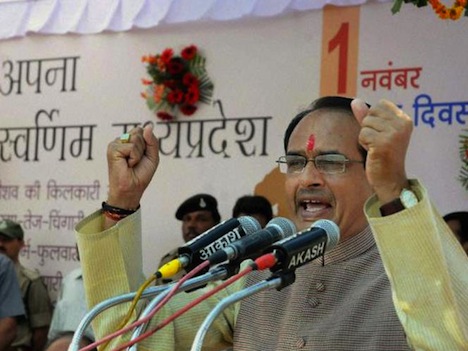
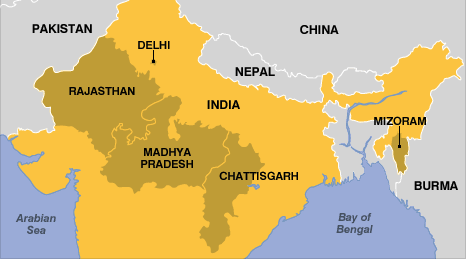
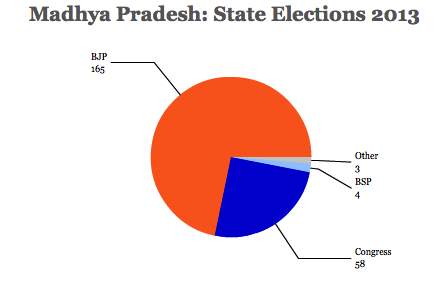
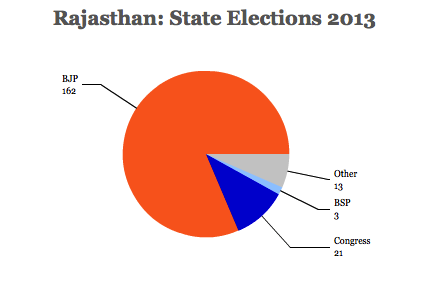
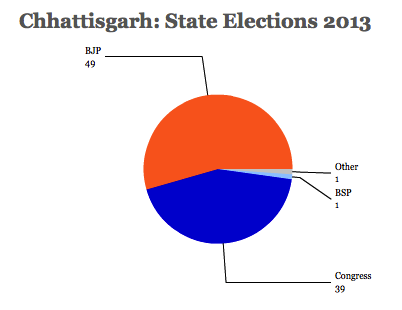
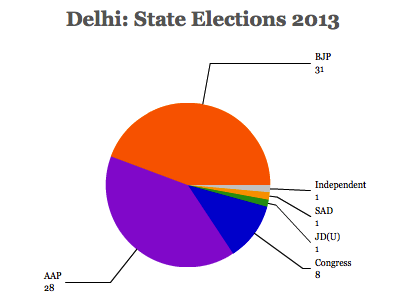
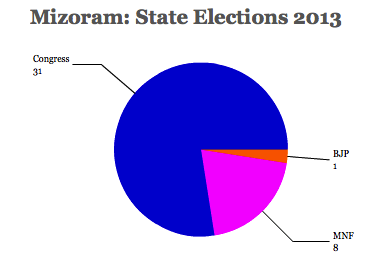
One thought on “Anti-incumbent momentum rises with BJP gains in northern Indian regional elections”